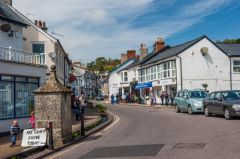
History
The first thing to clear up is the origin of the name; it has nothing to do with an alcoholic drink, but comes from the Saxon word 'bearu' for 'grove', a reference to the woodland once grew thick around this area of the coast.
Beer grew up around a sheltered bay which made fishing easier than at other places along the Jurassic Coast. But fishermen were not the only ones to make use of Beer; smugglers also appreciated the relatively easy anchorage and used caves in the cliffs to store contraband goods. There is no natural harbour at Beer so boats had to be winched up onto the shingle. This used to be done manually with a capstan on the shore which required 20 men to operate. Now electrically driven winches make light work of the task!

One of the more unusual features of the High Street is a brook that runs along the street to the shore. It has been channelled through an open conduit, but before the channel was built the brook was allowed to run along the street. It was used by fishermen cleaning their catch, who would simply toss the gutted remains of fish into the street and let the brook wash it away.
Not surprisingly, the smell became a problem, and Lady Rolle, the wife of the lord of the manor, was so bothered by the odour that she ordered the course of the brook to be diverted into a new stone culvert.
On the High Street is St Michael's church, built in 1878 on the site of an earlier 16th-century chapel. The chapel itself may have replaced a church built in 1122 when the abbey of Sherborne owned both Beer and nearby Seaton.
The monks grew grapes at a vineyard here, and the village was required to pay an annual tithe of fish, salt, and wine. Inside the west door of the church is the Washbourne Light, which used to stand atop the cliffs, where it would guide fishermen home safely.

Beer Quarry Caves
The most famous attraction here is the Beer Quarry Caves. Beer stone was highly prized as early as the Roman times. The Romans used it for many of their most important public buildings and were the first to quarry the stone from a rocky outcrop just outside the current village. Quarrying continued here, following the limestone seams underground, for almost 2000 years until the caves finally closed in the 1920s.
Beer stone is easy to work and has a soft golden colour after it has been exposed to the air. The stone was used in over 20 cathedrals around England, including Westminster Abbey, St Paul's Cathedral, and Exeter Cathedral. You can take excellent tours of the caves (I can highly recommend the tours, but dress warmly!).
During the 16th century, Flemish weavers settled in Beer, and made the area a centre for the lace-making trade. So famous did Beer lace become that Queen Victoria commissioned the women of Beer to create a lace flounce for her wedding dress in 1840.
The long-distance South West Coast Path runs along the cliffs at Beer. One particularly good walk links Beer to the beach at Branscombe to the west.
Beer is a very popular destination for tourists, and there are a large number of restaurants, cafes, and places to get ice-cream, along with a number of shops catering to regional gifts, crafts, and artwork. The Peco model railway company runs Pecorama, a pleasure garden and light railway ride.








 We've 'tagged' this attraction information to help you find related historic attractions and learn more about major time periods mentioned.
We've 'tagged' this attraction information to help you find related historic attractions and learn more about major time periods mentioned.



